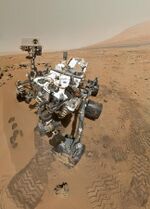Astronomy:2012 KP24
| Discovery[1] | |
|---|---|
| Discovered by | MLS |
| Discovery site | Mount Lemmon Obs. |
| Discovery date | 23 May 2012 |
| Designations | |
| 2012 KP24 | |
| Minor planet category | Apollo · NEO[2] |
| Orbital characteristics[2] | |
| Epoch 2022-Aug-09 (JD 2459800.5) | |
| Uncertainty parameter 6 | |
| Observation arc | 5 days |
| |{{{apsis}}}|helion}} | 2.0514 astronomical unit|AU (Q) |
| |{{{apsis}}}|helion}} | 0.94483 AU (q) |
| 1.4981 AU (a) | |
| Eccentricity | 0.36932 (e) |
| Orbital period | 1.83 years |
| Mean anomaly | 182.83° (M) |
| Mean motion | 0° 32m 14.388s /day |
| Inclination | 18.467° (i) |
| Longitude of ascending node | 67.445° (Ω) |
| |{{{apsis}}}|helion}} | ~2023-Jul-04 |
| 221.51° (ω) | |
| Earth MOID | 0.0002 astronomical unit|AU (30,000 km; 0.078 LD) |
| Physical characteristics | |
| Mean diameter | 17 m[3] |
| Mass | 7.2×106 kg (est.)[3] |
| Rotation period | 0.041667 h[2] |
| Apparent magnitude | 13.3 (2012 passage)[4] 21.6? (2023 passage)[5] |
| Absolute magnitude (H) | 26.4[2] |
2012 KP24 (also written 2012 KP24) is a Chelyabinsk-sized near-Earth asteroid with an observation arc of only 5 days and has a modestly determined orbit for an object of its size.[2] Around 31 May 2023 ±3 days it will pass between 0.19–24 lunar distances (73,000–9,200,000 km) from Earth.[2] Nominally the asteroid is expected to pass 0.026 astronomical unit|AU (3,900,000 km; 10 LD) from Earth and brighten to around apparent magnitude 21.6.[5]
It is a fast rotator that rotates in 0.04 hours (2.4 min).[2] The asteroid is estimated to be 17 meters (56 ft) in diameter.[3] It will next come to perihelion (closest approach to the Sun) around 4 July 2023.[2] It has an orbital uncertainty parameter of 6.[2]
2012
It was discovered on 23 May 2012 by the Mount Lemmon Survey at an apparent magnitude of 20.8 using a 1.5-meter (59 in) reflecting telescope.[1] On 28 May 2012 at 15:20 UT, the asteroid passed 0.00038 astronomical unit|AU (57,000 km; 35,000 mi) from the center-point of Earth.[2] It then reached perihelion on 2 July 2012. It was removed from the Sentry Risk Table on 8 August 2013 after Sentry updated to planetary ephemeris (DE431).[6]
2032
Newer versions of Sentry returned the object to the risk table. Virtual clones of the asteroid that fit the uncertainty region in the known trajectory show a 1 in 2.1 million chance that the asteroid could impact Earth on 2032 May 28.[3] With a Palermo Technical Scale of −6.30,[3] the odds of impact by 2012 KP24 in 2032 are about 2 million times less[7] than the background hazard level of Earth impacts which is defined as the average risk posed by objects of the same size or larger over the years until the date of the potential impact.[8]
References
- ↑ 1.0 1.1 "MPEC 2012-K52 : 2012 KP24". IAU Minor Planet Center. 2010-05-24. http://www.minorplanetcenter.net/mpec/K12/K12K52.html. Retrieved 2013-03-02. (K12K24P)
- ↑ 2.0 2.1 2.2 2.3 2.4 2.5 2.6 2.7 2.8 2.9 "JPL Small-Body Database: (2012 KP24)". https://ssd.jpl.nasa.gov/tools/sbdb_lookup.html#/?sstr=2012KP24&view=OPC. Retrieved 1 April 2016.
- ↑ 3.0 3.1 3.2 3.3 3.4 "Earth Impact Risk Summary: 2012 KP24". NASA/JPL Near-Earth Object Program Office. Archived from the original on May 12, 2013. https://web.archive.org/web/20130512032925/http://neo.jpl.nasa.gov/risk/2012kp24.html. Retrieved 2022-10-18. (1.1e-07 = 1 in 9,091,000 chance)
- ↑ "2012KP24 Ephemerides for 28 May 2012". NEODyS (Near Earth Objects – Dynamic Site). http://newton.spacedys.com/neodys/index.php?pc=1.1.3.1&n=2012KP24&oc=500&y0=2012&m0=5&d0=28&h0=0&mi0=0&y1=2012&m1=5&d1=29&h1=0&mi1=0&ti=30&tiu=minutes. Retrieved 2013-03-02.
- ↑ 5.0 5.1 "Horizons Batch for 2023-05-31 NOMINAL". JPL Horizons. https://ssd.jpl.nasa.gov/horizons_batch.cgi?batch=1&COMMAND=%272012+KP24%27&START_TIME=%272023-05-10%27&STOP_TIME=%272023-06-10%27&STEP_SIZE=%271%20day%27&QUANTITIES=%2709,20%27. Retrieved 2022-10-18.
- ↑ "Date/Time Removed". NASA/JPL Near-Earth Object Program Office. http://neo.jpl.nasa.gov/risk/removed.html. Retrieved 2013-08-11.
- ↑ Math: 106.30 = 1,995,262
- ↑ "The Palermo Technical Impact Hazard Scale". NASA/JPL Near-Earth Object Program Office. 31 Aug 2005. http://neo.jpl.nasa.gov/risk/doc/palermo.html. Retrieved 2011-10-14.
External links
- 2012 KP24 at NeoDyS-2, Near Earth Objects—Dynamic Site
- Ephemeris · Obs prediction · Orbital info · MOID · Proper elements · Obs info · Close · Physical info · NEOCC
- 2012 KP24 at ESA–space situational awareness
- 2012 KP24 at the JPL Small-Body Database
 |



